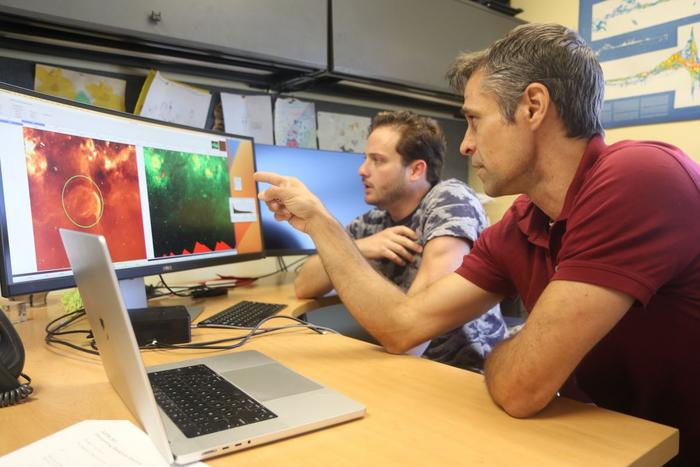A West Virginia University astronomer is searching the Milky Way for debris left behind by supernovas, the violent explosions that occur when massive stars die.

Credit: WVU Photo/Nathaniel Godwin
A West Virginia University astronomer is searching the Milky Way for debris left behind by supernovas, the violent explosions that occur when massive stars die.
After a supernova explosion, material that was part of the star expands outward, forming a shell or “remnant.” According to Loren Anderson, professor at the Eberly College of Arts and Sciences, studying supernova remnants is “essential for understanding the properties and dynamics of our galaxy — but there is a severe discrepancy in the number of supernova remnants we would expect to see compared to the relatively low number we have detected.”
Around 300 to 400 supernova remnants have been identified in the Milky Way, but studies of similar galaxies suggest closer to 1,000 supernova remnants likely exist in this galaxy. With $331,170 in National Science Foundation funding, Anderson will close that gap. He believes he could double the number of known supernova remnants by the end of his three-year study.
Identifying supernova remnants requires sensitive data and can be challenging. For instance, Anderson said supernova remnants are often confused with the much more numerous HII regions, clouds of dense plasma that surround massive stars.
Working with graduate student Timothy Faerber of Potomac, Maryland, Anderson will use radio wavelength data from the Very Large Array and MeerKAT telescopes to identify supernova remnant candidates, combining machine-learning software with old-school scanning “by eye.” This method will enable Anderson to discover new supernova remnants, confirm suspected supernova remnants and remove incorrectly identified remnants from the catalog.
“This study is timely,” said Anderson, astronomy professor and member of the WVU Center for Gravitational Waves and Cosmology. “Recent data from MeerKAT allow for the most sensitive search for supernova remnants yet, and recent works have identified hundreds of possible supernova remnants that need to be confirmed. We have already begun an initial search of a few square degrees of GPS data from the MeerKAT telescope and the results are incredibly promising.”
He said his methodology is well suited to discovering supernova remnants in crowded parts of the inner galaxy, increasing the odds of finding newer remnants that still haven’t spread out or dispersed far. Those “young, compact” remnants are especially valuable to researchers interested in supernovas’ impacts on interstellar matter and radiation.
But Anderson said every newly confirmed remnant is an opportunity for detailed study — a chance to create three-dimensional reconstructions of the material flung out by a supernova explosion, for example, or to learn more about what the shock of a supernova does to other matter in the galaxy.
He added the project also marks an opportunity to find supernova remnants that are associated with pulsars. A pulsar is the ultra-dense, rotating core that remains after a star has exploded in a supernova. Even though pulsars and supernova remnants are both created by supernova explosions, they’re rarely found in association.
Pulsars are important because their highly precise “pulsing” allows them to serve as cosmic clocks for astronomers, including Anderson’s WVU colleagues who in June made international headlines for discovering ripples in spacetime, thanks in large part to their study of pulsars.
Anderson’s research group will work with the West Virginia Science Public Outreach Team, which trains WVU undergraduates to deliver STEM presentations to K-12 students, making classrooms part of current, cutting-edge science that’s happening locally.
None of WV SPOT’s existing presentations showcase supernovas, Anderson said, so they will develop a new module that also provides a general overview of radio telescopes. The presentation will incorporate supernova remnant observations that will be acquired live from a telescope at the observatory in Green Bank, giving students hands-on, real-time experience with astronomy.




